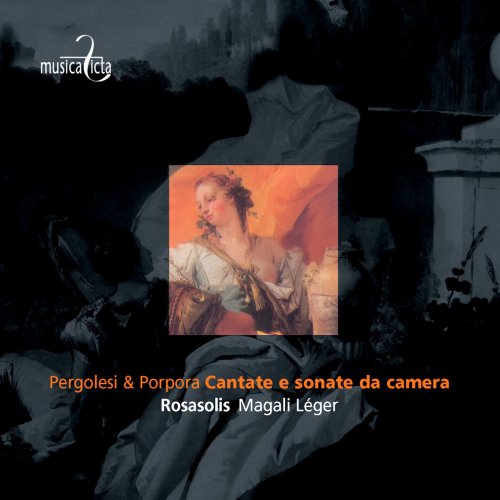
Magali Léger - Pergolesi & Porpora: Cantate e sonate da camera (2010)
BAND/ARTIST: Magali Léger, RosaSolis
- Title: Pergolesi & Porpora: Cantate e sonate da camera
- Year Of Release: 2010
- Label: Musica Ficta
- Genre: Classical
- Quality: FLAC (tracks+booklet)
- Total Time: 67:56 min
- Total Size: 373 MB
- WebSite: Album Preview
Tracklist:
01. Orfeo, Op. 2, No. 4: I. Recitativo "Nel chiuso centro"
02. Orfeo, Op. 2, No. 4: II. Amoroso "Euridice, e dove sei""
03. Orfeo, Op. 2, No. 4: III. Recitativo "Si, che pieta non v'e"
04. Orfeo, Op. 2, No. 4: IV. Presto "O d'Euridice n'andro fastoso"
05. Sinfonia da camera a 3, Op. 2, No. 2: I. Adagio
06. Sinfonia da camera a 3, Op. 2, No. 2: II. Allegro
07. Sinfonia da camera a 3, Op. 2, No. 2: III. Affetuoso
08. Sinfonia da camera a 3, Op. 2, No. 2: IV. Allegro
09. Lontananza "Dalsigre ahi! Mia Dalsigre", Op. 2, No. 1: I. Recitativo "Dalsigre ahi! Mia dalsigre"
10. Lontananza "Dalsigre ahi! Mia Dalsigre", Op. 2, No. 1: II. Aria (Andante )"Dite ch'ogni momento"
11. Lontananza "Dalsigre ahi! Mia Dalsigre", Op. 2, No. 1: III. Recitativo "Se pietà non vi muove"
12. Lontananza "Dalsigre ahi! Mia Dalsigre", Op. 2, No. 1: IV. Aria (Presto) "Torni volando"
13. Sinfonia da camera a 3, Op. 2, No. 3: I. Adagio sostenuto
14. Sinfonia da camera a 3, Op. 2, No. 3: II. Allegro
15. Sinfonia da camera a 3, Op. 2, No. 3: III. Adagio
16. Sinfonia da camera a 3, Op. 2, No. 3: IV. Aria Prima
17. Sinfonia da camera a 3, Op. 2, No. 3: V. Aria Secunda
18. Segreto Tormento "Chi non ode e chi non vede", Op. 2 No. 3: I. Tempo giusto "Chi non ode e chi non vede"
19. Segreto Tormento "Chi non ode e chi non vede", Op. 2, No. 3: II. Recitativo "Di costei parlo"
20. Segreto Tormento "Chi non ode e chi non vede", Op. 2, No. 3: III. Largo Recitativo "Tu dovresti, Amor Tiranno"
21. Segreto Tormento "Chi non ode e chi non vede", Op. 2, No. 3: IV. "Cadro contento"
01. Orfeo, Op. 2, No. 4: I. Recitativo "Nel chiuso centro"
02. Orfeo, Op. 2, No. 4: II. Amoroso "Euridice, e dove sei""
03. Orfeo, Op. 2, No. 4: III. Recitativo "Si, che pieta non v'e"
04. Orfeo, Op. 2, No. 4: IV. Presto "O d'Euridice n'andro fastoso"
05. Sinfonia da camera a 3, Op. 2, No. 2: I. Adagio
06. Sinfonia da camera a 3, Op. 2, No. 2: II. Allegro
07. Sinfonia da camera a 3, Op. 2, No. 2: III. Affetuoso
08. Sinfonia da camera a 3, Op. 2, No. 2: IV. Allegro
09. Lontananza "Dalsigre ahi! Mia Dalsigre", Op. 2, No. 1: I. Recitativo "Dalsigre ahi! Mia dalsigre"
10. Lontananza "Dalsigre ahi! Mia Dalsigre", Op. 2, No. 1: II. Aria (Andante )"Dite ch'ogni momento"
11. Lontananza "Dalsigre ahi! Mia Dalsigre", Op. 2, No. 1: III. Recitativo "Se pietà non vi muove"
12. Lontananza "Dalsigre ahi! Mia Dalsigre", Op. 2, No. 1: IV. Aria (Presto) "Torni volando"
13. Sinfonia da camera a 3, Op. 2, No. 3: I. Adagio sostenuto
14. Sinfonia da camera a 3, Op. 2, No. 3: II. Allegro
15. Sinfonia da camera a 3, Op. 2, No. 3: III. Adagio
16. Sinfonia da camera a 3, Op. 2, No. 3: IV. Aria Prima
17. Sinfonia da camera a 3, Op. 2, No. 3: V. Aria Secunda
18. Segreto Tormento "Chi non ode e chi non vede", Op. 2 No. 3: I. Tempo giusto "Chi non ode e chi non vede"
19. Segreto Tormento "Chi non ode e chi non vede", Op. 2, No. 3: II. Recitativo "Di costei parlo"
20. Segreto Tormento "Chi non ode e chi non vede", Op. 2, No. 3: III. Largo Recitativo "Tu dovresti, Amor Tiranno"
21. Segreto Tormento "Chi non ode e chi non vede", Op. 2, No. 3: IV. "Cadro contento"
The chamber cantata for perhaps one or two singers accompanied by a small ensemble of strings and continuo would have been bread and butter in the career of any Italian composer, and for many Germans, over much of the Baroque period. But this enormous repertory remains little investigated. The three chamber cantatas of Giovanni Battista Pergolesi recorded here were celebrated works in their time, published shortly after the composer's untimely death in 1736, and they're superb works, on a par with Pergolesi's better-known sacred masterpieces. Consider the opening Orfeo, published as Pergolesi's Op. 2/4, with its multisectional eight-minute movement marked Amoroso, "Euridice e dove sei?: It's not clear whether Pergolesi knew Monteverdi's operatic treatment of the Orpheus legend, from more than a century before, or whether he drew on a tradition coming down from that work. But the entire movement, and indeed, the entire cantata, is a dazzling mixture of styles reaching back to the 17th century and up-to-the-minute galant melody. Also of interest are the two Porpora works entitled Sinfonia da camera a tre. Although he was Haydn's teacher and attained international fame, this composer remains little performed; these instrumental works suggest something of the nature of his influence on Haydn (hear the unexpected somberness of the Affetuoso movement of the Sinfonia da camera a tre, Op. 2/2, track 7), and they make ideal intermezzi for the Pergolesi cantatas. The program, then, is very strong, but sample the voice of soprano Magali Léger before buying; this singer is not a specialist in Baroque music, and while she's quite expressive in many passages, she plays fast and loose with the pitch. The overresonant church sound is another minus.
As a ISRA.CLOUD's PREMIUM member you will have the following benefits:
- Unlimited high speed downloads
- Download directly without waiting time
- Unlimited parallel downloads
- Support for download accelerators
- No advertising
- Resume broken downloads


